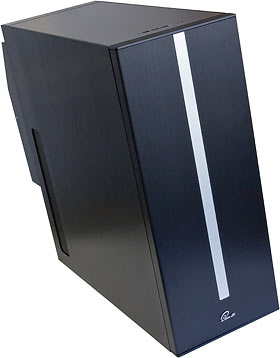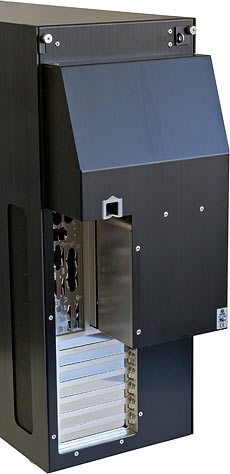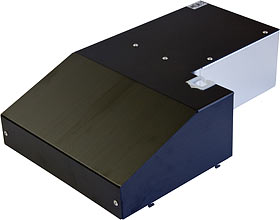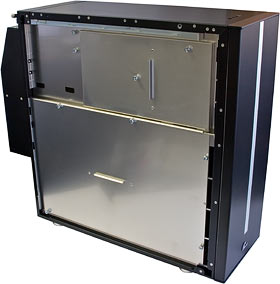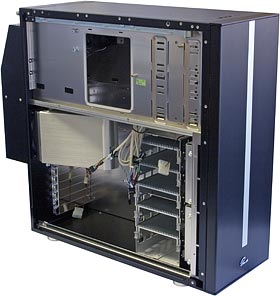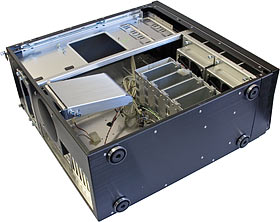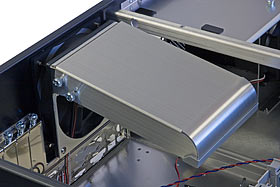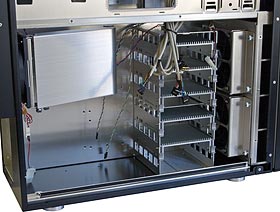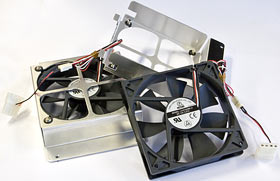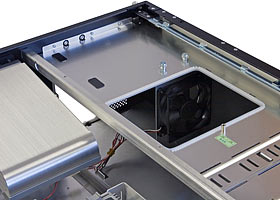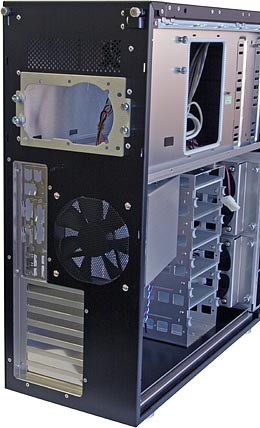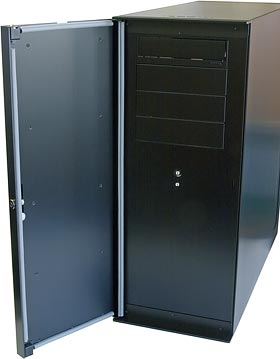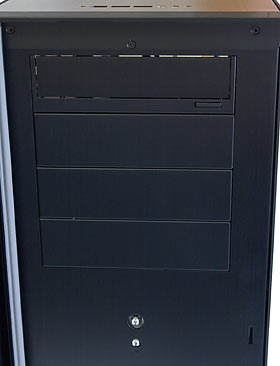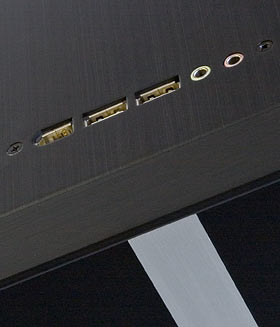
Lian Li PC-S80 PC case
Review date: 13 July 2006 Last modified 03-Dec-2011.
You know what?
If you want a silent computer, just forget it. It's not worth the trouble.
Oh, sure, it can be done. There are several ways. Cool-running fanless CPUs, solid state drives. But if you want a really and truly silent PC with ordinary drives in it, you're going to need to vibration-isolate the moving parts with things like these, and then be pretty careful with your heat management.
And, yes, you could also get yourself one of the models of Mac with no fan. Old PowerPC iMacs, G4 Cubes, that kind of thing. The more boring models are cheap as chips on eBay these days, though hardly front runners in the performance department.
Really, though, you've got to resign yourself to at least a bit of noise even with those, because they've got normal drives in them. If you want to use off-the-shelf PC components and keep them cool, some noise is unavoidable. But you can minimise it if you get a case with some noise-absorbing, fan-baffling features.
Like this one, for instance. It's Lian Li's PC-S80, and it combines several interesting computer-silencing ideas with some of the innovations of their striking PC-V1000.
As with most of their cases, Lian Li make the S80 in in black and silver versions, and Aus PC Market here in Australia stock both of them. The black one sells for $AU478.50, including delivery in the Sydney metropolitan area (delivery elsewhere in the country costs a bit more, but even if you're in Perth you'll only pay $AU30 more, which isn't bad for a place that's a 3,950 kilometre drive from the AusPC warehouse). The silver S80, however, is for some reason $AU511.50, so you'd have to be pretty darn enthusiastic about the brushed aluminium look to buy it.
Since both S80s have a lockable front door that covers all of the externally visible drives, you don't have to buy special black drives in order to avoid Piebald PC Syndrome if you get the cheaper black S80. Beige drives in a silver case look just as bad anyway, if you ask me.
(In the USA at the moment, the situation seems to be reversed, with the black version costing more than the silver one. That's the normal order of things. Australia's odd pricing probably has something to do with hemispheres.)
Even the black version's price is, of course, quite a lot for a computer case which, like other Lian Lis, doesn't even come with a power supply.
But you do, literally, get a lot of case for your money.
The S80 is an unremarkable 210mm (8.3 inches) wide, and a not-that-huge 590mm (23.2 inches) deep and tall. It's got four 5.25 inch bays hidden behind its front door, and five internal 3.5 inch bays. So if you want a floppy drive, you'll either have to use an external one or mount it in adapter rails in a 5.25 bay.
So the S80's not huge, but it weighs 13.2 kilograms, versus about eight kilos for the PC-V1000. The older "PC-60 style" Lian Lis are around six kilos.
The S80's made almost entirely out of aluminium, of course; it wouldn't be a Lian Li if it weren't. So the extra weight doesn't come from heavy metal. It comes from more metal, as you soon discover when you start taking the thing apart.
The back of the S80's dominated by a big air-duct thingy, which you don't have to remove to open the case. If you want to remove it, though, it's easy to do; the duct is held in place with the same sort of hook-tab arrangement that retains the sides of most PC cases.
The function of the duct's not immediately obvious from the outside, though you can see the neat little clip-in grommet that gives you somewhere to park your power cable.
Flip the thing over, though, and you can see that (a) it's lined with noise-reducing foam, and (b) it's got two compartments.
The idea is that one compartment matches an intake fan (a nice big 120mm one), and the other matches the outflow from the PSU. Without this doodad, warm air that's just left the S80 will get sucked back in again, unless you turn some fans around inside the case.
Few PC cases get this clever with their air flow. They generally just have a front-to-back air path, with any and all rear fans blowing outward and any and all front ones sucking inward. That works OK, but air entering the front of the case, and the fans sucking it in, make noise. As we'll see, the S80 has no front intakes at all.
The S80's side panels are big solid pieces of aluminium, just like the side panels of the V1000. As with the V1000, though, it's very easy to remove them. You just undo a single captive thumbscrew on the appropriate top back corner...
...and slide out the catch that the screw retains, and then the whole panel hinges down into your hands. You don't have to do any of the panel-sliding malarkey that normal PC cases require. This is good, because while slide-lock panels are usually easy to remove, they can be a pain to replace.
When I first took the side panel off the S80, though, I was flummoxed by the following view.
This looks for all the world like what you see if you remove the wrong side panel from a case. Do that and you end up looking at the back of the motherboard tray, which is not something that most people ever need to do. You usually only take off that side panel to get access to the far side of the drive bays; there's seldom any reason to touch the back of the motherboard area.
This, though, is not the motherboard tray - though I admit to peeking under the panel on the other side of the case to verify that there wasn't some kind of spatio-temporal inversion going on. This weirdness is actually part of the S80's air flow design.
See, air gets into the S80 through the vertical grilles toward the back of the side panels. It flows forward through the gap between the inside of the side panel and the outside of these secondary panels underneath, then into the true body of the case through vertical vents at the front.
To see what happens to it then - or to actually get at any components - you have to either remove the secondary panels, or port over the neat-o little Flash animation on the S80 product page (see it as big as your browser window here!).
It's easy enough to remove the secondary panels, since they're retained by another bunch of Lian Li's signature thumbscrews. There's more vibration-damping rubber on the inside of one of them, but it hasn't been added as an afterthought; it neither sticks to anything nor jams the panel in place.
Underneath, you find something that resembles the inside of a normal PC case.
Closest to the camera in this photo is the motherboard mounting area, which is shaded by an awning-shaped air director that's fed by the 120mm rear intake fan. The awning is, of course, removable (more thumbscrews) so you can actually get a motherboard into the case (any normal ATX or smaller board will fit). You can still get at the expansion card area with the awning in place, though; the cards are as usual retained with yet more thumbscrews.
Once your PC's built, the idea is that the awning lines up more or less with the CPU socket. You push the awning down on its hinge until it sits close to the CPU fan and maximises air flow onto it.
As an exhaust, the awning wouldn't work very well. As an intake, it's a good idea. Choose a cool-ish CPU and you could actually run it with a large heat sink and no fan of its own at all.
Of course, if the awning doesn't line up with the CPU socket(s) on your mobo, you might as well just remove it altogether. The rear fan will still direct air onto the motherboard in general.
Between the mobo area and the front of the case, there are the 3.5 inch drive bays (five of 'em) and the fans that drive the S80's twisty-turny air flow.
The bays (which Lian Li call a "crowding shape bracket") are cousins to the 3.5 inch bays in the V1000, in that they let you slide drives in without using tools and then clip them in place with sliding plastic latches. The V1000 achieved this feat with special screws for the sides of the drives; the S80 does it with whole removable trays into which you screw your drives.
The trays are aluminium, of course, and should provide considerable heat sinking for drives mounted in them.
Consumer hard drives can stand running surprisingly hot, but it's still not a great idea to test their strength.
In ordinary computer cases, drives get hot because there's very little cooling air flowing over them and/or because they're cheek-by-jowl with another drive. Or, worse yet, sandwiched between two other drives.
Hard drives produce significant heat whenever they're spinning, because of friction between the air inside the drive and the platter(s) (compare and contrast: Tesla turbine), so if you want to stop the meat in a hard drive sandwich from getting very hot you either have to make sure that one or more of the drives is likely to be in spun-down sleep mode at any given time, or have to blow a noisy hurricane of cooling air over the whole arrangement.
The S80 drive bays, like the V1000 ones, make it impossible for you to mount your drives with only tiny gaps between them. And, in typical Lian Li fashion, the cooling fans are right in front of the bays and blowing around the ends of the drives as well as through the bay cage.
The down side of this spaced-bays setup is that you can't fit as many drives in the same space, but five still ought to be enough for most people. It's not a hard limit, anyway; you can use cheap adapter rails to install 3.5 inch drives in spare 5.25 inch bays if you like.
The S80's front fans are 120mm units, identical to the rear fan but mounted in removable frames. They've got ball bearings and they only spin at 1500RPM, which means they ought to last close to forever without maintenance.
Each of these fans is, according to the sticker, rated at 0.27 amps. Multiply that by 12 volts and you get 3.24 watts. Their actual running power is probably a bit lower; they'll draw a bit more (but not burn up) if they're jammed and unable to spin.
Three watts is a high-medium kind of fan power, and it and their diameter means these fans move more air than most. Lian Li rates them at 56.3 cubic feet per minute (CFM).
To get that kind of flow figure out of a mere eighty millimetre fan, you need to drive it at something like 4000RPM with about a four watt motor. That gives you a much louder fan - in the 45dBA-at-one-metre range, compared with the mere 24.7dBA rating of the Lian Li fans.
The mystical behaviour of the human ear means that this roughly 20dB difference causes the 4000RPM 80mm fan to sound about four times as loud as the 1500RPM 120mm one.
The actual amount of air the fans manage to move through the S80 per minute will be a lot lower than their rating might lead you to expect. CFM numbers for fans are always free-air ratings - they're what the fan manages when it's just hanging in space, not pushing air through a case. These fans are trying to move air through a Z-shaped path before it even gets to them, and then push it out through the power supply mounting area. Normal PSUs have at least one fan of their own (and there's yet another fan, which we'll get to in a moment), but there's still a quite large amount of resistance in this air path. Air does not like turning corners, especially sharp ones - and narrow, wide ducts like the ones in the S80's walls are real turbulence adventures.
On the other hand, the two fans at the front of the S80 really only have to cool the drives and stir a bit more air through the case to stop the 5.25 inch drives from dying of heat stroke. And the circuitous air path does mean there are no inlets or outlets at the front of the S80, and plenty of stuff between the user and the front fans. And those front fans are mounted on rubber bushings that stop some of their vibration from being transmitted to their frames; the frames, in turn, each have a strip of rubber on their screw-on flanges.
Here's the power supply corner of the S80.
The PSU mounts in the same way it does in various other Lian Lis. There's a plate on the back of the case that you remove and screw onto the PSU, then you post the resulting assembly back into the case through the plate's mounting hole, and re-fasten the plate's thumbscrews. If your PSU has a protruding grille on its top or bottom then you may have to mount it the traditional way, by threading it through the case from the inside, but you'll still be able to turn the plate either way up so you can install your PSU with its grille facing up or down.
The space above where the PSU installs, however, remains empty in the S80. And, lurking in the shadows in the above picture, you can see an 80mm fan facing into said space. The idea is that the PSU doesn't have to contribute anything much to the overall air flow; exhaust air mainly bypasses it, and is escorted out of the case by the 80mm fan, which is far enough inside the case that not much of its own noise gets out.
And, of course, what noise does escape runs into the exterior split-duct thingy, and is further attenuated.
What this all means is that you can install a quiet PSU with a thermally controlled fan in the S80 without worrying about that PSU messing up the air flow for the whole case. You could even install a fanless PSU, or a hybrid like Antec's Phantom 500 which only turns its fan on when it has to. The Phantom 500 is unusually long and so won't fit in some cases, but there's plenty of room in the S80.
On the other hand, the rear exhaust grille fed by the 80mm fan isn't all that huge, as you can see when the rear duct's removed.
So that's another minus in the S80 Air Flow Equation; the PSU and that rear vent, after all, have to exhaust all of the air the S80 inhales.
O, the complexity.
The door on the vent-less front of the case has a rubber gasket around its edge, to quieten things down even more.
The top 5.25 inch bay has a "stealth" panel that lets you install a white drive behind it without spoiling the look of the case - but I don't know whether I'd bother, seeing as there's that darn great door and all.
The other aluminium 5.25 inch bay covers are just clipped in place, as is normal for Lian Li cases, so they're very easy to remove when you want to install drives. As is also normal for Lian Li, though, the covers are secure enough that they won't buzz or rattle. If your Lian Li case is making such a noise, it's probably because you forgot to tighten some thumbscrews when you reassembled it.
There's one odd thing on the front panel, though - the power and reset buttons.
Or lack thereof.
All you get for these two functions is the above-pictured nude switches, with no actual buttons attached to them. This is no big deal, since the door conceals the switches most of the time and it's not actually at all difficult to press them. But when I first saw them, I thought that someone at the factory must have forgotten to press the buttons in place, or that they'd fallen off in transit.
Nope; there never were any. Don't bother looking. Apparently some S80s had buttons, but the current ones don't.
The switches have LEDs in the middle of them - power LED in the power switch, drive LED in the reset switch. That doesn't matter much either, since you can't see them when the S80's door is closed.
The S80 has ports on its front, as is normal for cases these days - you get an unremarkable single FireWire, two USB and two audio connectors, all of which can be hooked up to most motherboards with the usual spray of fiddly little connectors.
Unusually, though, the ports aren't on the front of the case, exactly.
They're on the front of the top panel, facing upwards.
Many cables and short-cabled devices will, therefore, therefore look a bit weird when plugged into them. The ports may also collect dust, I suppose, though not necessarily any more than many other front ports do - often, the computer's fans suck air in through them.
So how quiet is it?
Good question. I have no answer for you.
Oh, I can tell you how much fan noise escapes the PC-S80: Very little. And I can guarantee you that noisy internal components - whining video card or CPU cooler fans, and to some extent even spin-cycle optical drives - will sound quieter in the S80 than in almost any other case. That includes the older PC-6070, which was basically just a PC-60 with a door, but probably doesn't include this very expensive thing.
How much noise your computer will actually make if you build it in an S80, though, I don't know. That depends on what you put in it, and also on what you do with it, since lots of modern PC gear has thermally controlled fans. CPU coolers, PSUs, motherboard chipset coolers and graphics cards can, thus, all be very quiet when the computer's idling and a lot louder when you're working it hard.
There are too many variables to say anything definite, though. The S80's circuitous air path means that it doesn't actually get a whole lot of throughflow ventilation compared with many ordinary cases. That doesn't mean it'll overheat - I'd be confident putting arbitrarily speedy hardware in this enclosure, though it's not the best choice for overclockers - but it does mean that it's definitely going to run warmer than a high-airflow case, especially a wide open cheese-grater like the V1000. More heat means faster fan speeds and more noise; you can't change just one variable.
If you really want to move a lot of air through a twisty turny path, you can do it with a great big fan, but what you really need is a device with a different ratio of free-air flow to static pressure. Static pressure is the amount of pressure increase a given air-mover can create when it's blowing into a sealed box, and it's not the strong suit of plain rotary fans.
You don't see a lot of centrifugal blowers hooked up to PC cases, but it certainly can be done (and overdone!). To get a lot of static pressure and reasonable efficiency, though, you need a rotor/stator setup, probably with at least two "stages" - sets of rotating and static vanes.
That sounds very complex and jet-engine-y, but it's actually the way that many ordinary vacuum cleaner suction motors work, as all civilised people of course already know. An old vacuum blower running at rather lower power and hooked up to the exhaust vent would probably shift air through an S80 very nicely indeed. The main reason why nobody sells such an arrangement commercially is, I think, just that it takes up a lot more space than a normal fan, especially if you add a noise muffler to the output.
Getting back to the real world, where you put your computer also affects its noise level. You'll obviously hear less noise from a PC if it's further away from you, all other things being equal, but there are other tricks you can use to quieten things down. Hang sound absorbent material on the wall behind the PC, for instance. Something as simple as an old blanket, duct taped to the wall, will do. You can use similar treatments on other surfaces around the computer that reflect sound toward you. You can even stick or hang absorbent material on the computer's panels to make them less resonant, as long as you don't cover any vents. PCs get very nearly all of their cooling from the air flow through them, so it's fine to cover all of the panels with blanketty stuff if you like; the computer won't run measurably hotter.
(And yes, this means that case manufacturers who say their cases run cooler because they're made from aluminium are not telling the truth. Aluminium has much better thermal conductivity than steel, so it's possible that aluminium cases can cool hard drives and any other components that get little airflow and are screwed directly to the case just a hair better, but if you built the exact same chassis out of steel, the cooling difference would be trivial. Fancy aluminium cases usually have more fans and more inlet and output vents than do cheap steel cases; that's what makes the difference.)
You can also gin up your own S80-style rear air redirector out of cardboard. Part of the reason why the S80's redirector quietens the case down is that both of its vents face downward, so they reflect noise into the carpet.
Don't let all this put you off, though. If you're looking for a case that really will make a given bunch of hardware noticeably quieter, the S80 is that case.
Overall
The S80 gets high marks in almost all of the usual Lian Li departments. It's nicely made, it looks good, it's easy to work on (those V1000-type side panels are really nice), and it's not terribly expensive for what you get. If you're pinching pennies then you can save the price of a perfectly good video card by buying a basic case instead of a fancy one like this, but the S80's target market is people who are willing to pay for quietness as well as style. And the thing still only costs about as much as the old Lian Li full towers; they've made some much more expensive cases.
Unlike normal Lian Lis, the S80 isn't a particularly light case, but that's not very important. It's not easy to tell the difference between a supposedly lightweight case and a normal steel one, once you've built a computer into them both.
There's also no slide-out motherboard tray, but this case isn't cramped enough that you really need one. Sliding a mobo right out requires various cables to be unplugged, so what most people use slide-out trays for, if they use them at all, is sliding the mobo out a couple of inches so they can get at the RAM slots. That shouldn't be much of a problem with the S80.
If you're fiddling with your computer all the time then the S80's extra internal panels may be a pain, but there's nothing stopping you just leaving the inner and outer panels off and running your computer half-nude while you're diagnosing that RAM problem or swapping drives around or whatever.
This thing isn't a perfect Cone of Silence for your PC, and if you're a player of 3D games or eager to build some other high-powered maybe-overclocked box, you're likely to find the increased fan speeds from the gear inside the enclosure largely cancel out its sound insulation. And, furthermore, who cares if the S80's own fans last forever, if your video card fan wears out after eight months?
If you're willing to work with the S80 instead of against it, though, you can get a lot of CPU and video card power for not that much heat these days. Especially if you use some mildly odd components. Build a PC based on some flavour of Core processor - they're not that expensive these days - and add a video card with no fan at all, and your computer will be very quiet even if you put it in an ordinary case.
The S80's ideally suited to a system like that, but it'll also do a good job of quieting down normal midrange PCs, definitely including most game machines. An S80 won't get along as well with really high heat components, so those of you who're in love with 70% overclocks and 10,000RPM hard drives should look elsewhere.
For everyone else, though, the S80 gets a "recommended" from me.
Buy one!
Australian shoppers can purchase the PC-S80 from Aus PC Market.
For the black version,
click here;
for the silver version,
click here.
(If you're not in Australia or New Zealand, Aus PC Market won't deliver to you. If you're in the USA, try a price search at DealTime!)
